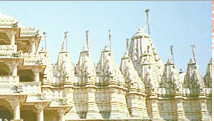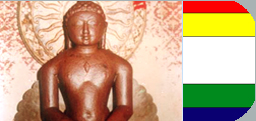
|
||||||||
|
Adinath Bhagwan : Life Rishabha was born to King Nabhi Raja and Queen Marudevi at Ayodhya in the Ikshvaku clan. According to Jain beliefs, Rishabh existed before civilization developed. He taught people agriculture, tending of animals, cooking, and more. He had one hundred and one sons. His eldest son - Bharat - was a chakravarti king - the conqueror of the known world. In the later part of his life he retired to become a monk and attained moksha. Since he became a siddha, he is occasionally worshipped. According to the Jain beliefs, India was named Bhārata-varsha or Bhārata after him. His second son was Bahubali, whose statue stands at Shravanabelagola, Karnataka as well as at Karkala. Marudevi mother of adinath was the first person[citation needed] to achieve moksha - even before Rishabh himself. Rishabh's grandson Marichi's soul later became Mahavira[citation needed]. He attained 'kevalgnan' or infinite knowledge at Palitana and attained liberation (moksha) at Ashtapad mountain in Himalayas. Birth of Rishabhdev (Adianth Bhagwan) The Age of the Twins With the passage of time gradual changes occurred and around the end of the third Ara the yield from the Kalpa-vrikshas reduced. The alround deterioration in conditions spelled the beginning of quarrels and disputes. To guard against these disputes and to live in peace and harmony, man formed groups and the Kulkar system was evolved. A number of people collected to form a ‘Kula’ (family) and the head of the group was called ‘Kulkar’. It was the duty of the ‘Kulkar’ to remove discord and establish order. Nabhiraja was the seventh and the last in the line of Kulkars. His wife was Marudeva. This epoch of Kulkar system was known as the epoch of twins (Yugalia). A human couple used to give birth to a twin- one male and one female. This twin would become husband and wife on reaching adulthood. The twins used to lead a happy and contented life and died a natural death together. To consume what was available was the way of life. As such this period was also known as Bhog-Bhumi-Kaal or the era of free consumption. Up to the time of Kulkar Nabhiraja man lived in this land of abundance. |
||||||||
|
|

 |
| Every soul is divine and has the potential to achieve God-consciousness. Any soul which has conquered its own inner enemies and achieved the state of supreme being is called “jina” more.... |
There is no overarching supreme being, divine creator, owner, preserver or destroyer. Every living soul is potentially divine and the Siddhas, those who have completely eliminated their karmic bonds to end their cycle of birth and death, have attained God-consciousness. |
Sammed Shikharji Girnarji Mahavirji Mangi Tungi Shatrunjaygiri Palitana Kundalgiri Mahuaji more.... |
 |
Jiyo Aur Jine Do..... (Mahavir Bhagwan) | |
 |
Bhagwan Rishabha (Adinath) Ji Bhagwan Ajitnath Ji Bhagwan Sambhav Nath Ji Bhagwan Abhinandan-Nath Ji Bhagwan Sumatinath Ji Bhagwan Padmaprabha Ji Bhagwan Suparshvanath Ji Bhagwan Chandra-Prabha Ji |
Bhagwan Pushpadanta Ji Bhagwan Shitalnath Ji Bhagwan Shreyamsanath Ji Bhagwan Vasupujya Ji Bhagwan Vimalnath Ji Bhagwan Anantanath Ji Bhagwan Dharmanath Ji Bhagwan Shantinath Ji |
Bhagwan Kunthunath Ji Bhagwan Aranath Ji Bhagwan Malinath Ji Bhagwan Munisuvrata Ji Bhagwan Naminath Ji Bhagwan Neminath Ji Bhagwan Parshvanath Ji Bhagwan Mahavira Ji |


